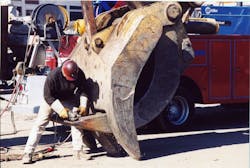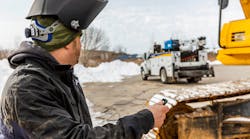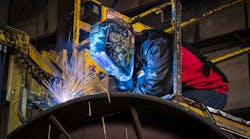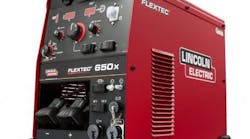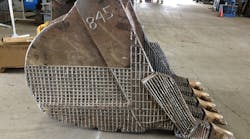Because metal failure—whether it’s a bucket edge or something more serious such as a loader arm or crane extension—can mean major downtime on the job site, managers should have at least some knowledge of best practices and trends in welding, as well as what equipment is a solid investment for field service trucks.
Common Field Failures
“From a large front-end loader perspective, when you’re dealing with rocks and boulders, something is bound to crack over time,” says Chris Wierschke, product manager for Miller Electric. “So you’ll use a generator to power tools to clean up the areas that will need a new plate—you cut or gouge the old metal away, grind away dirt, paint, rust, and other contaminants, and weld new metal in its place.
“Another common repair is when backhoe bucket teeth crack off or break on a rock,” Wierschke says. “When that happens, you’ve got to get the old tooth off of there, grind back the old section or carbon arc gouge it.”
Carbon arc gouging is one of three ways to remove damaged metal. Oxy-fuel and plasma cutting are used more often to actually cut through, or sever, a piece of metal, but carbon arc gouging does a better job with cracks or defects.
For carbon arc gouging, you’ll need a welding generator that has an output of 250 to 500 amps. The process itself uses a carbon electrode to melt the affected area. A high-pressure blast of air gets rid of the molten metal.
Miller recommends sizing the welding generator to the carbon diameter you want to run. For best performance during carbon arc gouging, spec a welding generator with at least 200 amps for 3/16-inch carbon diameters, 300 for 1/4-inch, 350 for 5/16-, and 450 for 3/8-inch.
Field Maintenance Considerations
Most metal mishaps occur far away from the shop, where the weld environment is less than pristine. “Right away, you have to worry about the material you’re fixing,” Wierschke says. “You’re not dealing with clean, paint-free metal. You have to remove the rust, the dirt, and the paint with a grinder.
“Once contaminants are removed, for the majority of repair applications out in the field, maybe 95 percent, stick welding will do the trick,” Wierschke says, “and you don’t have to worry about the wind blowing your shielding gas away because it is a self-shielded process.
“With solid wire, you have an inert gas that is shielding the weld puddle from environmental impacts, so you’ve got to get away from the wind or make your own barrier.
“With a self-shielded flux-cored welding, as I’m burning, I’m making my own shielding gas, so I don’t have to worry about that. In stick welding, there’s a flux on the outside of the rod that creates its own protection area as it burns in order to protect the weld from environmental impacts,” Wierschke explains.
“If you’re welding plain carbon steel, from a portability standpoint, stick electrode is great for that,” says Keith Packard, segment manager, power generation and refineries, for Hobart Brothers. “It’s a relatively simple process, and the equipment is cheaper. You just need a ‘stinger,’ which holds the electrode attached to a power supply able to run constant current.”
Packard says solid wire is the least-used technology for field repair, with stick electrodes and flux-cored wire (if there’s a wire-fed power supply) being the top two.
“One thing to be aware of is that not all wires can weld in all positions,” Packard says. “You need to weld up, or across; you’re not always going to be dealing with a flat piece of plate, like in the shop. Out in the field, you need the capability to weld all over a unit. So make sure you set yourself up with different positional capabilities.”
Protective Equipment, Filler Metals
“The biggest thing for welding in the field is all your personal protective equipment,” Packard says. “From a welding process perspective, make sure your material is as clean as can be. If it’s cold outside, bring the material up to 70 degrees, or room temperature. The arc is the same temperature as the sun, so if something’s cold and you put heat into it really fast, that’s not good. Plus, pre-heating the material helps the quality and the cooling rate of the weld, as well.”
Packard also stressed access to the weld. “It’s tough to weld behind another plate, so remove what’s in the way and really understand what you’re welding on.”
It’s also important to have a working knowledge of filler metal, and, before undertaking any major welding repair, to consult the equipment distributor/manufacturer to ensure that the proper filler metals are used. Finally, check that a self-made repair won’t void any warranties.
“Think about some of the basics on filler metals,” Packard says. “How strong is it? Does it have the ability to resist impact—will it crack like glass when you hit it with a hammer, or mushroom like clay? That’s especially important for cold weather.
“Then there are mechanical properties: strength, toughness. Is it ductile; can it resist stretching? If your filler metal is not ductile, it can’t stretch. If you’re repairing something with a lot of loading on it, you don’t want to use a filler metal that’s not ductile. If you’re just welding a garbage can and holding parts together, that’s one thing. If you have a weld that fails on a crane and people die, that’s a big problem,” Packard says.
Communication with your technicians is key, according to Lincoln Electric’s Eric Snyder, senior product manager-Engine Driven Welders. “Ask questions to make sure that the repair need and the welding process are understood before the repair begins,” Snyder says. “Being clear on the objective, the welding procedure and other specifics of the process will help ensure that the repair is done correctly and will be durable.”
Outfitting Field Service Trucks
The biggest keys to choosing welding equipment for a service truck will be what your technicians need and the room available on the truck.
“Most contractors will own their own service trucks, so if they’re going to sink $110,000 into a truck, it makes sense to have $4,000 of welding equipment tied into that,” Wierschke says.
But you have to tie it in an efficient way. “Combination” generator equipment allows managers to buy welding equipment together with other necessities for field repair, all in one unit.
“When you’re dealing with space constraints, you have to think about what else the mechanics have to do,” Wierschke says. “What can you do to lighten the mechanic’s load and yet provide space for other things?”
Manufacturers of today’s engine-driven welding generators have responded with truck-bed-fitting boxes featuring both welding and power-generation capabilities, as well as air compressors.
Self-contained rotary screw air compressors will not only run air tools, but will also run plasma cutters.
Wierschke also identified two types of service trucks that may help dictate what kind of combination equipment to purchase.
On a truck without a crane, Wierschke says managers should think about a single unit with a multi-process output (for welding and air tools, including plasma cutters), at least 13,000 watts of generator power, a rotary screw compressor, and a battery charger, or jump starter, to provide the most features while taking up the least amount of space.
According to the company, such a single unit takes up only half the bed space of a separate, engine-driven air compressor and welder/generator.
“If you do have a hydraulic crane on the truck, it makes sense to purchase equipment that can power the crane, provide air power, and provide welding generator power, all without the truck idling,” Wierschke says.
Versatility is a necessity to tackle a wide range of field repair situations.
“You can remove the bad steel with arc gouging or with a power tool driven through the generator power of the machine,” Wierschke explains, “then you can clean that weld joint and get the dirt, paint and grease out of there with grinders powered by the generator on the machine. Then comes the welding, and all of that work can be done out of one box, on one truck.”
Finally, consider what type of fuel you will use for your engine drive. Welding generators that run on gasoline are generally smaller and lighter weight. A newer trend, electronic fuel-injected gasoline welding generators offer reduced fuel consumption and emissions.
Diesels often use less fuel than similar gasoline-powered products.
“Industrial diesel welders are generally more expensive than commercial gasoline or LPG welders,” Lincoln’s Snyder says. “You can get more life out of a diesel engine through overhauls, and they’re also more suitable for longer repair jobs. Gas welders will start more easily in cold weather without starting aids and winterized fuel.”
Also, always be sure to check local regulations and company policies where your crew is working, as certain sites may prohibit diesel and gasoline engines, and instead call for LPG welding generators. “All engine-driven welders should be operated in open spaces with adequate ventilation,” Snyder says.
